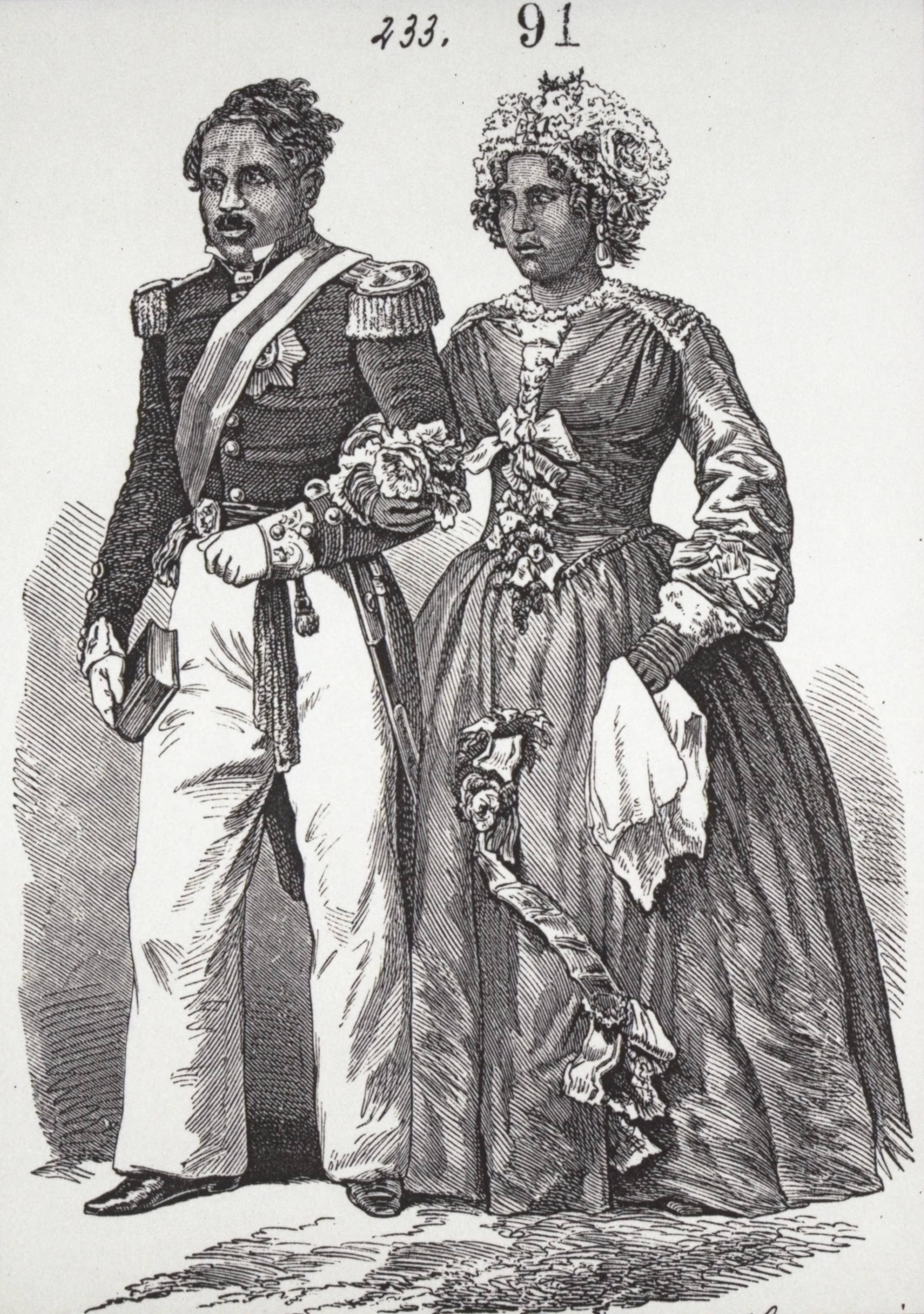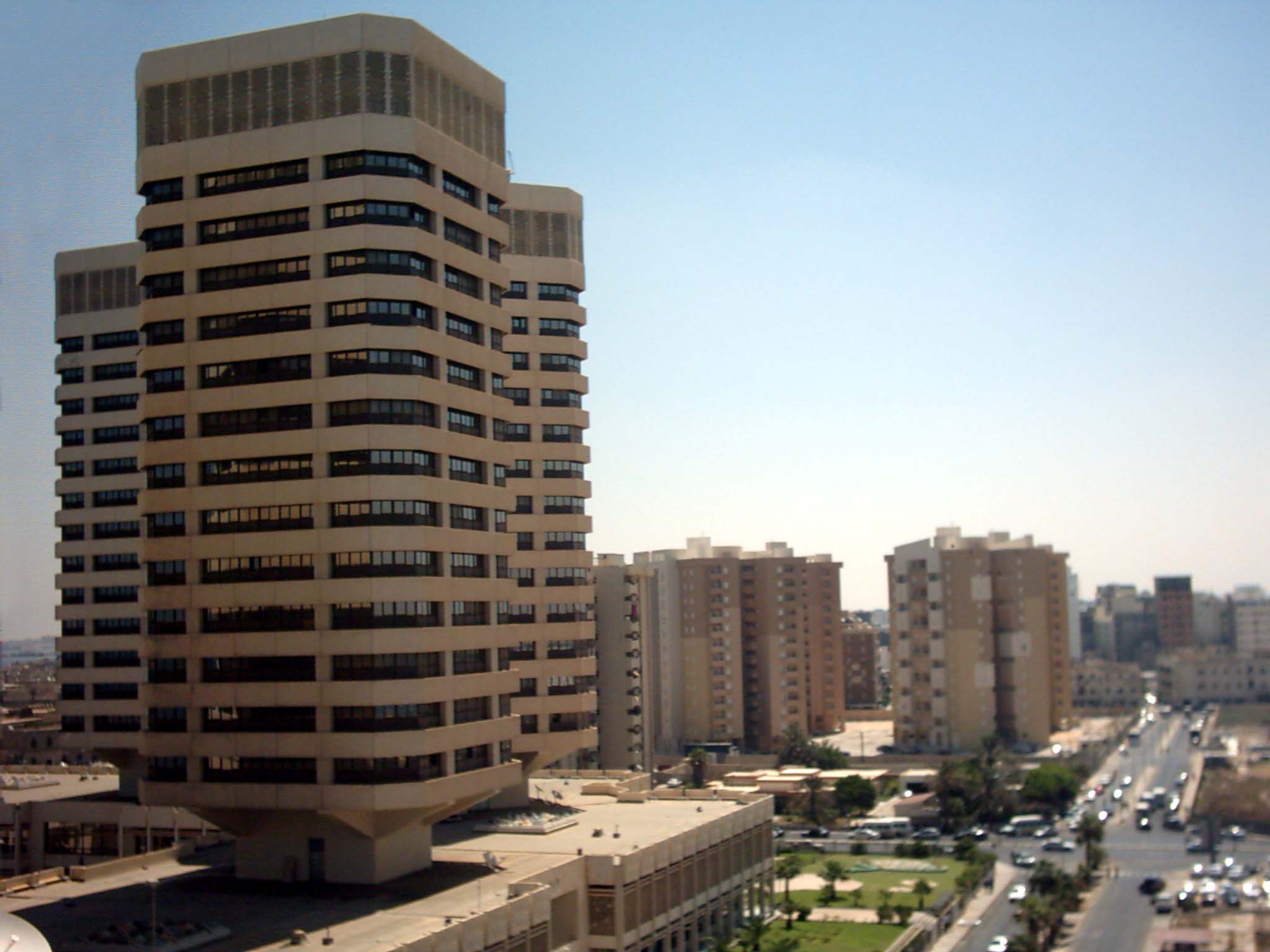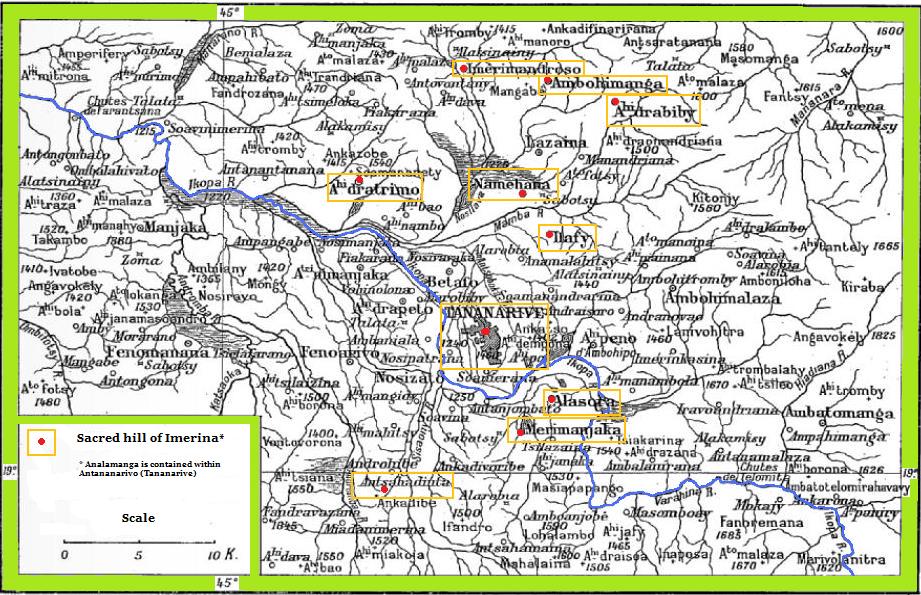|
Radama II
Radama II (September 23, 1829 – May 12, 1863 'contested'' was the son and heir of Queen Ranavalona I and ruled from 1861 to 1863 over the Kingdom of Madagascar, which controlled virtually the entire island. Radama's rule, although brief, was a pivotal period in the history of the Kingdom of Madagascar. Under the unyielding and often harsh 33-year rule of his mother, Queen Ranavalona I, Madagascar had successfully preserved its cultural and political independence from European colonial designs. Rejecting the queen's policy of isolationism and persecution of Christians, Radama II permitted religious freedom and re-opened Madagascar to European influence. Under the terms of the Lambert Charter, which Radama secretly contracted in 1855 with French entrepreneur Joseph-François Lambert while Ranavalona still ruled, the French were awarded exclusive rights to the exploitation of large tracts of valuable land and other lucrative resources and projects. This agreement, which was l ... [...More Info...] [...Related Items...] OR: [Wikipedia] [Google] [Baidu] |
List Of Imerina Monarchs
This article lists the Imerina monarchs, from the earliest origins of the Merina monarchy until the French conquest of the Merina Kingdom during the Second Madagascar expedition. Early monarchs in the Merina line Below is a list of the line of Merina monarchs that ruled in the Central Highlands of Madagascar and from whom were issued the first true monarchs of a united Madagascar in the 19th century. Before the uniting of Madagascar, succession was based on the current monarch's designation of an heir, typically from among his or her own children. As such, the list below represents a direct genealogical line from the last 19th-century queen of Madagascar to some of the earliest known rulers identified in the 15th century or before. Prior to the 16th century, detailed information about the names and dates of Merina rulers becomes less consistent. Genealogy in this early period are derived primarily from oral history, while later names and dates are verifiable from primary source ... [...More Info...] [...Related Items...] OR: [Wikipedia] [Google] [Baidu] |
Merina
The Merina people (also known as the Imerina, Antimerina, or Hova) are the largest ethnic group in Madagascar.Merina people Ethnic Groups of Madagascar Encyclopædia Britannica They are the "highlander" Malagasy ethnic group of the African island and one of the country's eighteen official ethnic groups. Their origins are mixed, predominantly with |
Ambohimanga
Ambohimanga is a hill and traditional fortified royal settlement ('' rova'') in Madagascar, located approximately northeast of the capital city of Antananarivo. It is situated in the commune of Ambohimanga Rova. The hill and the rova that stands on top are considered the most significant symbol of the cultural identity of the Merina people and the most important and best-preserved monument of the precolonial Merina Kingdom. The walled historic village includes residences and burial sites of several key monarchs. The site, one of the twelve sacred hills of Imerina, is associated with strong feelings of national identity and has maintained its spiritual and sacred character both in ritual practice and the popular imagination for at least four hundred years. It remains a place of worship to which pilgrims come from Madagascar and elsewhere. The site has been politically important since the early 18th century, when King Andriamasinavalona (1675–1710) divided the Kingdom of I ... [...More Info...] [...Related Items...] OR: [Wikipedia] [Google] [Baidu] |
Lamba (garment)
A lamba is the traditional garment worn by men and women that live in Madagascar. The textile, highly emblematic of Malagasy culture, consists of a rectangular length of cloth wrapped around the body. Traditional lambas used for burial were often made of silk and cow hides while those for daily wear were more often made of raffia, pig skin, cotton or bast. They could range in color from a tie-dyed mess or solid white cloth, to striped red, white and black cloth found in most parts of the island, the geometric patterns in unique shades of green and brown produced by a handful of Sakalava villages, or the brilliantly multi-colored, complex weaves favored by the pre-colonial Merina aristocracy. Today, it is common to find printed cotton or rayon lambas produced in India for the Malagasy market in addition to those fabricated locally.Green, R.L. (2003). Lamba hoany: proverb cloths from Madagascar. ''Africa Arts, 36''(22), pp. 30–46. Besides its daily use as basic clothing, the l ... [...More Info...] [...Related Items...] OR: [Wikipedia] [Google] [Baidu] |
William Ellis, The Prince And Princess Royal Of Madagascar
William is a male given name of Germanic origin.Hanks, Hardcastle and Hodges, ''Oxford Dictionary of First Names'', Oxford University Press, 2nd edition, , p. 276. It became very popular in the English language after the Norman conquest of England in 1066,All Things William"Meaning & Origin of the Name"/ref> and remained so throughout the Middle Ages and into the modern era. It is sometimes abbreviated "Wm." Shortened familiar versions in English include Will, Wills, Willy, Willie, Bill, and Billy. A common Irish form is Liam. Scottish diminutives include Wull, Willie or Wullie (as in Oor Wullie or the play ''Douglas''). Female forms are Willa, Willemina, Wilma and Wilhelmina. Etymology William is related to the given name ''Wilhelm'' (cf. Proto-Germanic ᚹᛁᛚᛃᚨᚺᛖᛚᛗᚨᛉ, ''*Wiljahelmaz'' > German '' Wilhelm'' and Old Norse ᚢᛁᛚᛋᛅᚼᛅᛚᛘᛅᛋ, ''Vilhjálmr''). By regular sound changes, the native, inherited English form of the name should ... [...More Info...] [...Related Items...] OR: [Wikipedia] [Google] [Baidu] |
Marc Ravalomanana
Marc Ravalomanana (; born 12 December 1949) is a Malagasy politician who was the President of Madagascar from 2002 to 2009. Born into a farming Merina family in Imerinkasinina, near the capital city of Antananarivo, Ravalomanana first rose to prominence as the founder and CEO of the vast dairy conglomerate TIKO, later launching successful wholesaler MAGRO and several additional companies. He entered politics upon founding the Tiako Iarivo political party in 1999 and successfully ran for the position of mayor of Antananarivo, holding the position from 1999 to 2001. As mayor he improved sanitary and security conditions in the city. In August 2001 he announced his candidacy as an independent in the December 2001 presidential election. He then took office as president in 2002 amidst a dispute over election results in which he successfully pressed his claim to have won a majority in the first round. Under the leadership of Jacques Sylla, Ravalomanana's Prime Minister from 2002 to ... [...More Info...] [...Related Items...] OR: [Wikipedia] [Google] [Baidu] |
2009 Malagasy Political Crisis
The 2009 Malagasy political crisis began on 26 January 2009 with the political opposition movement led by Antananarivo mayor Andry Rajoelina, which sought to oust President Marc Ravalomanana from the presidency. The crisis reached its climax in the 2009 Malagasy coup d'état when Andry Rajoelina was declared the president of the High Transitional Authority of Madagascar on 21 March 2009, five days after Ravalomanana transferred his power to a military council and fled to South Africa. The international community immediately condemned the leader and his ascension as unconstitutional, characterising the move as a coup. Financial support and foreign investments stopped, and the country fell into one of the worst economic crises in its history. The SADC and the African Union were designated to supervise Madagascar's political reinstatement. Though the objective of the transitional government was to run presidential elections as soon as possible to relieve the tensions (despite re ... [...More Info...] [...Related Items...] OR: [Wikipedia] [Google] [Baidu] |
Daewoo
Daewoo ( ; Hangul: , Hanja: , ; literally "great universe" and a portmanteau of "dae" meaning great, and the given name of founder and chairman Kim Woo-choong) also known as the Daewoo Group, was a major South Korean chaebol (type of conglomerate) and automobile manufacturer. It was founded on 22 March 1967 as Daewoo Industrial and was declared bankrupt on 1 November 1999, with debts of about US$50 billion (equivalent to $ billion in ). Prior to the 1997 Asian financial crisis, Daewoo was the second largest conglomerate in South Korea after the Hyundai Group. There were about 20 divisions under the Daewoo Group, some of which survived as independent companies. History Beginning and development The Daewoo Group was founded by Kim Woo-choong in March 1967. He was the son of the Provincial Governor of Daegu. He graduated from the Kyonggi High School, then finished with an Economics Degree at Yonsei University in Seoul. During the 1960s, after the end of the Syngman Rhee ... [...More Info...] [...Related Items...] OR: [Wikipedia] [Google] [Baidu] |
Andriana
Andriana refers to both the noble class and a title of nobility in Madagascar. Historically, many Malagasy ethnic groups lived in highly stratified caste-based social orders in which the ''andriana'' were the highest strata. They were above the Hova (free commoner castes) and Andevo (slaves). The Andriana and the Hova were a part of ''Fotsy'', while the Andevo were ''Mainty'' in local terminology. The Andriana strata originally constituted the nobility, warrior, and land owning class of the Merina society. They were endogamous and their privileges were institutionally preserved. While the term and concept of Andriana is studied with the Merina people of Madagascar, the term is not limited to them. The use of the word "Andriana" to denote nobility occurs among numerous other Malagasy ethnic groups such as the Betsileo, the Betsimisaraka, the Tsimihety, the Bezanozano, the Antambahoaka and the Antemoro. ''Andriana'' often traditionally formed part of the names of Malagasy kin ... [...More Info...] [...Related Items...] OR: [Wikipedia] [Google] [Baidu] |
Imerina
The Merina Kingdom, or Kingdom of Madagascar, officially the Kingdom of Imerina (–1897), was a pre-colonial state off the coast of Southeast Africa that, by the 19th century, dominated most of what is now Madagascar. It spread outward from Imerina, the Central Highlands region primarily inhabited by the Merina ethnic group with a spiritual capital at Ambohimanga and a political capital west at Antananarivo, currently the seat of government for the modern state of Madagascar. The Merina kings and queens who ruled over greater Madagascar in the 19th century were the descendants of a long line of hereditary Merina royalty originating with Andriamanelo, who is traditionally credited with founding Imerina in 1540. In 1883, France invaded the Merina Kingdom to establish a protectorate. France invaded again in 1894 and conquered the kingdom, making it a French colony, in what became known as the Franco-Hova Wars. History Hova-Vazimba conflict Madagascar's central highlands ... [...More Info...] [...Related Items...] OR: [Wikipedia] [Google] [Baidu] |
Ralambo
Ralambo was the ruler of the Kingdom of Imerina in the central Highlands region of Madagascar from 1575 to 1612. Ruling from Ambohidrabiby, Ralambo expanded the realm of his father, Andriamanelo, and was the first to assign the name of Imerina to the region. Oral history has preserved numerous legends about this king, including several dramatic military victories, contributing to his heroic and near-mythical status among the kings of ancient Imerina. The circumstances surrounding his birth, which occurred on the highly auspicious date of the first of the year, are said to be supernatural in nature and further add to the mystique of this sovereign. Oral history attributes numerous significant and lasting political and cultural innovations to King Ralambo. He is credited with popularizing the consumption of beef in the Kingdom of Imerina and celebrating this discovery with the establishment of the ''fandroana'' New Year's festival which traditionally took place on the day of Ral ... [...More Info...] [...Related Items...] OR: [Wikipedia] [Google] [Baidu] |
Twelve Sacred Hills Of Imerina
The twelve sacred hills of Imerina are hills of historical significance to the Merina people of Madagascar. Located throughout Imerina, the central area of the highlands of Madagascar, the sites were often ancient capitals, the birthplaces of key public figures, or the tomb sites of esteemed political or spiritual leaders. The first set of sacred sites was designated by early 17th-century king Andrianjaka. The notion was re-sanctified under late 18th-century king Andrianampoinimerina, who replaced several of the earlier sites with new ones. More than 12 sites were thus designated as sacred over time, although the notion of twelve sacred hills was perpetuated because of the significance of the number 12 in Malagasy cosmology. Today, little concrete evidence of the former importance of many of these sites remains, but the significant archeological and cultural heritage of several of the sites has been preserved. The historic significance of the sites is best represented by the ... [...More Info...] [...Related Items...] OR: [Wikipedia] [Google] [Baidu] |




.jpg)




